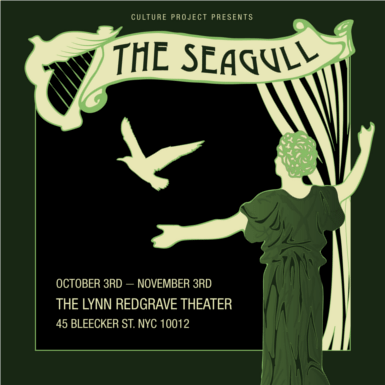

I must admit that I approached this production of "The Seagull" with high hopes. Its director, Max Stafford-Clark, has been an inspiring force both in the UK and on the theater world at large. Moreover, I am an enormous Chekhov enthusiast. Admittedly, it would be hard to meet such high expectations, yet even with this in mind, the production, sadly, fell far, far short.
The problem so often encountered with Chekhov, as writer Thomas Kilroy freely admits in his introduction in the program, is that people fall into the trap of playing it like a period piece. As Kilroy points out, British adaptations, in particular, have tended to construct a very artificial, drawing-room type drama. It is, therefore, ironic that this indeed becomes the central problem of the production. It is not that the play suffers from a lack of acting talent: the cast is filled with remarkable performers from both sides of the pond. The problem arises in the direction, which coats the entire performance in a blanket of period, in a very particular idea of what nineteenth-century drama should be. This very British, very antiquated acting style, more demonstrative than truthful, becomes entirely uninteresting to watch. We feel very much like we are watching something from history, a museum piece that is performed, rather than a live, relevant, and vibrant piece of theatre.
It is saddening when a writer of Kilroy’s talent is given such an opportunity to adapt one of the master works of western theatre that the result should be so bland. The differences between the original and the adaptation seem to extend little beyond a few changes to the names of characters and places that situate the drama in western Ireland. It is thus unclear why Kilroy would bother with such an adaptation at all: he could have easily suggested this setting through costuming and dialect alone. His adaptation is the antithesis of Annie Baker’s "Uncle Vanya" at SoHo Rep last year, which demonstrated how a writer could adapt Chekhov and give it new relevance, biting wit, and contemporary satire without falling into a trashy, pop cultural adaptation. Kilroy’s wry Irish humor certainly adds a new dimension to the work and suggests an implicit connection between Russian and Irish sensibilities, particularly in the context of class divisions. Yet despite Kilroy’s emphasis on the “immediate troublesome moments of the here and now," the relevance of this production to our contemporary, present existence, to current Ireland, and to the class crisis in Europe or America was entirely lost behind a façade of period drama.
As mentioned, Stafford-Clark has assembled an excellent cast. Trudie Style is particularly brilliant as Isobel (Arkadina), carrying much of the first act with extravagance and humor. Rachel Spencer Hewitt is remarkable as Lily (Nina) – her change from innocent seagull to embittered woman is beautiful to watch. Yet the choice of Slate Holmgren to play Constantine is odd: Holmgren is clearly older than 25, and not only is his relationship to Isobel thus unconvincing, but his attempts to convey the youthful, almost-teenage angst of the character seem forced.
The set and costuming design (by Peter Hartwell and Ilona Somogyl, respectively) works in the context of Stafford-Clark's direction yet is ultimately entirely unsurprising and therefore uninspiring. The fake ivy and Greek columns emphasize the artifice of the production and construct a production that is more reminiscent of a regional, amateur acting troupe than an exciting off-Broadway performance.
Certainly the tragi-comic essence of Chekhov is created in this production. The family is both absurd and heartbreaking to watch. Yet ultimately the true and tragic humanity of this play, the rawness and relevance of its characters, is lost behind the veneer of antiquity and the pretense of period.
Performances of "The Seagull" continue at the Lynn Redgrave Theater through November 3rd. Check out our full event listing here: https://stagebuddy.com/listingdetail.php?lid=14494